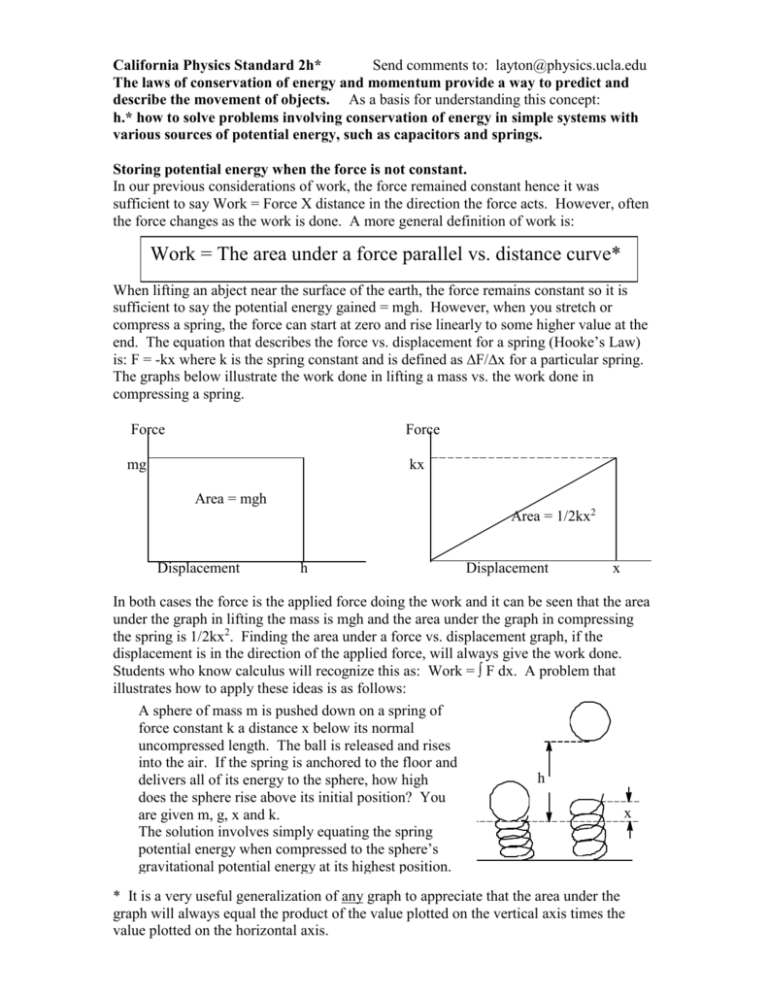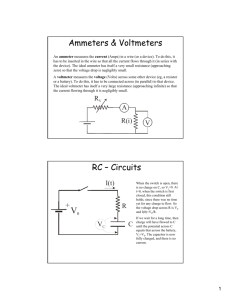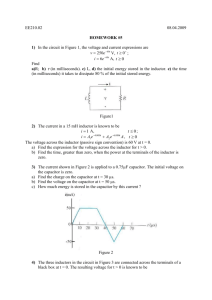Conservation of Energy and Momentum
advertisement

California Physics Standard 2h* Send comments to: layton@physics.ucla.edu The laws of conservation of energy and momentum provide a way to predict and describe the movement of objects. As a basis for understanding this concept: h.* how to solve problems involving conservation of energy in simple systems with various sources of potential energy, such as capacitors and springs. Storing potential energy when the force is not constant. In our previous considerations of work, the force remained constant hence it was sufficient to say Work = Force X distance in the direction the force acts. However, often the force changes as the work is done. A more general definition of work is: Work = The area under a force parallel vs. distance curve* When lifting an abject near the surface of the earth, the force remains constant so it is sufficient to say the potential energy gained = mgh. However, when you stretch or compress a spring, the force can start at zero and rise linearly to some higher value at the end. The equation that describes the force vs. displacement for a spring (Hooke’s Law) is: F = -kx where k is the spring constant and is defined as ∆F/∆x for a particular spring. The graphs below illustrate the work done in lifting a mass vs. the work done in compressing a spring. Force Force mg kx Area = mgh Area = 1/2kx2 Displacement h Displacement x In both cases the force is the applied force doing the work and it can be seen that the area under the graph in lifting the mass is mgh and the area under the graph in compressing the spring is 1/2kx2. Finding the area under a force vs. displacement graph, if the displacement is in the direction of the applied force, will always give the work done. Students who know calculus will recognize this as: Work = ∫ F dx. A problem that illustrates how to apply these ideas is as follows: A sphere of mass m is pushed down on a spring of force constant k a distance x below its normal uncompressed length. The ball is released and rises into the air. If the spring is anchored to the floor and h delivers all of its energy to the sphere, how high does the sphere rise above its initial position? You x are given m, g, x and k. The solution involves simply equating the spring potential energy when compressed to the sphere’s gravitational potential energy at its highest position. * It is a very useful generalization of any graph to appreciate that the area under the graph will always equal the product of the value plotted on the vertical axis times the value plotted on the horizontal axis. A problem which involves the same setup as the above but asks: “What is the position of the bottom of the sphere when it has its maximum kinetic energy?, requires a little more thought. Students may think they should simply equate 1/2 mv2 to 1/2kx2 but this assumes the sphere reaches its maxim speed just as it leaves the spring. However, the sphere will reach its maxim speed when the upward force of the spring equals the downward force of gravity (somewhat less than x) and it will be required to find this distance by equating ky to mg and solving for y. The above problem suggests an interesting activity that could be performed with a properly chosen compressible spring, a ball, a spring balance and a meterstick. The students would determine the spring constant using the meterstick and the spring balance. After determining the mass of the ball they could press it down a measured distance on the spring and see if it rises to the predicted height when released. Energy in a charged capacitor. (Included here only because energy storage in capacitors is briefly mentioned in the Framework. More details are included below.) The Framework suggests that this would be an appropriate time to discuss storing energy in a capacitor. Although details about electrical energy and capacitors will be presented later, here is an attempt to address the basic concepts: A capacitor stores charge. Although electrical charge is not energy, (electrical charge is one of the fundamental quantities of physics like mass and time) it does take energy to store charge in a capacitor. Filling a capacitor with charge is not like filling a glass with water. Storing charge in a capacitor is more like filling a steel tank with air. At first it takes only a little pressure to put the air in the tank but as more air is forced into the tank, more pressure is required to store even more air. In this analogy charge is like the air and voltage is like the pressure. The capacitance of a capacitor, C, is defined as the ratio of the charge Q stored, to the voltage V required to store this charge. That is, C = Q/V or, Q = CV. The unit of capacitance is the Farad and a one Farad capacitor will store one Coulomb of charge if a potential difference of one Volt is placed across it. In order to appreciate how this relates to energy, it is necessary to know that voltage (or potential difference) is a measure of energy per charge. That is, V=Energy/Charge or W/Q. The unit of potential difference is the volt and one volt is one joule per coulomb. Let’s look at a graph of charge vs. voltage when charging a capacitor: Charge Since from V = Energy/Charge, Energy = VQ, it follows that the Q area under a Charge vs. Voltage graph would equal the energy Area = 1/2QV required to charge the capacitor to a final voltage V. Hence, the energy in a charged capacitor = 1/2 QV and since Q = CV, it Potential Difference V follows that the energy of a charged capacitor = 1/2CV2 Suggested Activity to observe and measure energy in a charged capacitor. The following has yet to be developed but might have promise: Using one of the “new” low voltage yet large value capacitors (Jameco 42957CB 1 Farad @ 5.5V--$4.29 each) charged to 4 V, experiment with placing this across a small 3 V motor rigged to lift a small weight of, say 100 grams. Lifting this weight 1 meter would be about one joule. Repeating the lifting would cause the voltage to drop and should be discontinued when the motor no longer turns. Record the voltage during the experiment. (The final voltage should not be zero.) Analysis should allow computation of the energy stored in the capacitor and the percentage that was delivered to the motor lifting the weight. Different values of weight, etc. could be tried.

![Sample_hold[1]](http://s2.studylib.net/store/data/005360237_1-66a09447be9ffd6ace4f3f67c2fef5c7-300x300.png)






